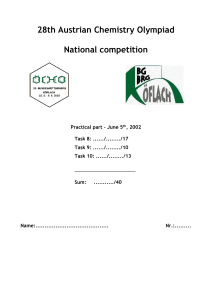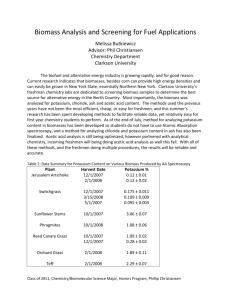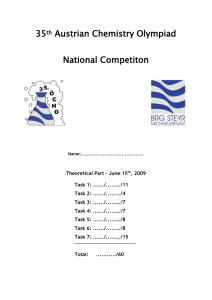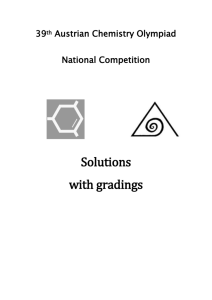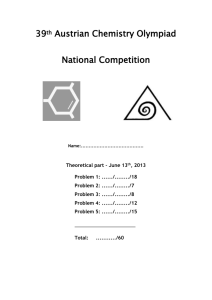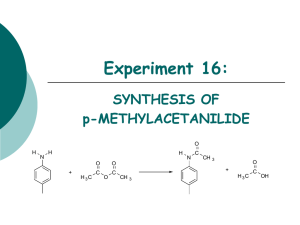Practical Examination
advertisement
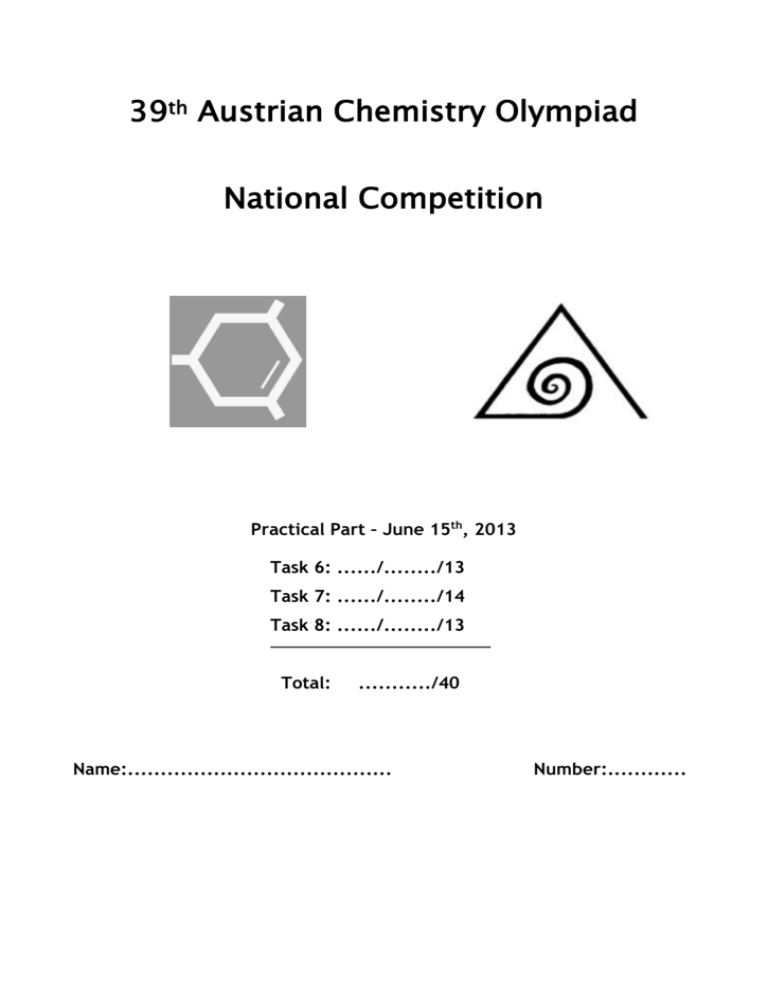
39th Austrian Chemistry Olympiad National Competition Practical Part – June 15th, 2013 Task 6: ....../......../13 Task 7: ....../......../14 Task 8: ....../......../13 Total: .........../40 Name:........................................ Number:............ 39th Austrian Chemistry Olympiad National Competition - Vienna Practical part – Tasks June 15th, 2013 Hints You have 5 hours time to complete the solutions of the competition tasks. You may only use this paper, draft paper, a non programmable calculator, and a blue or black biro, nothing else. Write your answers in the boxes provided for them. Only these answers will be marked. If you don’t have enough space, then you may write on the back of the pages with the remark “belongs to part x.xx“, whereby x.xx means the part of the task in italics. You may take the draft paper with you after the competition. You have to wear a lab coat and safety goggles (or your own optical spectacles) throughout the whole time in the lab. Schedule for the conductometers (chemistry lab) 09.00-09.50: places 1, 5, 9, 13 09.50-10.40: places 2, 6, 10, 17 10.40-11.30: places 3, 7, 11, 15 11.30-12.20: places 4, 8, 12, 16 Schedule for the conductometers (physics lab) 09.00-09.50: places 17, 19 09.50-10.40: places 18, 20 10.40-11.30: places 19, 21 11.30-12.20: places 22, 23 Data and formulae: M (H) = 1.0 g∙mol-1 M (C) = 12 g∙mol-1 M (N) = 14 g∙mol-1 M (O) = 16 g∙mol-1 𝑚 Amount of matter 𝑛=𝑀 molar concentration 𝑐=𝑉 equivalent conductivity Λ𝑐 = Kohlrausch-law Λ 𝑐 = Λ 0 − 𝑘 ∙ √𝑐 degree of dissociation 𝛼 = Λ𝑐 acid constant 𝐾𝐴 = 𝑛 𝜅𝑐 𝑐∙𝑧∓ ∙𝜈∓ Λ 0 2 𝛼2 1−𝛼 ∙ 𝑐0 39th Austrian Chemistry Olympiad National Competition - Vienna Practical part – Tasks June 15th, 2013 Task 6 13 points Qualitative analysis To analyse the given eight samples you have the following reagents at hand: zinc-granules - „Zn“ hydrochloric acid (half concentrated) „HCl“ ammonia solution (2M) - „NH3“ sodium hydroxide solution (2M) - „NaOH“ barium hydroxide solution (0,1 M) - „Ba“ sodium carbonate (solid) - „Na“ silver nitrate solution (0,1 M) - „Ag“ Be aware that you may also use chemicals from other experiments! Additional material: burner MgO-rod funnel filter paper pH-paper grid pattern for spot tests mortar with pestle small beaker or small Erlenmeyer flask with glass rod stand with Ceran plate Write your analytical results into the table: Sample Cation 1 2 3 4 5 6 7 8 3 Anion 39th Austrian Chemistry Olympiad National Competition - Vienna Practical part – Tasks June 15th, 2013 Task 7 14 points Quantitative analysis and physical chemistry conductivity of strong and weak electrolytes General remarks In this task you have to measure the specific conductivity of a strong (potassium chloride) and a weak electrolyte (acetic acid). From these measurements you will derive important relations of physical chemistry, and you will calculate constants of materials. You have two sub-tasks, for each of them a list of chemicals and apparatus, which you may use. You do not have detailed procedures. Therefore read the text of these tasks completely before you start your experimental work, and make plans, how to proceed. If you use glass ware several times for different solutions, think about a suitable cleaning and conditioning procedure. Write all results (readings, drawings, calculations) into the provided boxes. Take into account, that you can use a conductometer only within a certain time period. You have to fetch the conductometer from the lab assistant. Tasks a) Determination of the acetic acid concentration Determine the exact molar concentration of the acetic acid at your place. You have at hand: 1 1 burette with stand waste beaker 1 1 bottle with dropper and NaOH (0,100 M) PPP with phenolphthalein solution (0,1%) 2 1 volumetric pipettes (10/25) Peleus ball 1 1 solution of acetic acid (0,080-0,13 M) bottle with distilled water 1 titration flask 1 kitchen roll 7.1. Exact concentration of acetic acid: Chosen volume of acetic acid sample: Titration volume NaOH (mean value): Calculation: 4 39th Austrian Chemistry Olympiad National Competition - Vienna Practical part – Tasks June 15th, 2013 b) Measure of the specific conductivity of strong and weak electrolytes For this part of the task you have the chemicals and apparatus in the table below at your disposal. In any case measure the specific conductivity of the two stock solutions. Thereby start with the KClsolution. If the value of your conductometer, which, by the way, you are only allowed to turn on and off, nothing else, does not lie between 12.70 and 13.05 mS∙cm-1, call the lab assistant. Now prepare, using the stock solutions, a suitable series of dilutions from the stock solutions. Then measure the specific conductivities of these solutions with the help of the plastic beakers. Take into account, that you have about 200 mL of KCl-stock solution, from which you need some for direct measurement, you have about 170 mL HAc, from which you have needed some for titration, and some for direct measurement, you have to use some apparatus more than once, you may use the conductometer only for about 50 minutes in the given time interval. 4 1 2 1 1 100 mL volumetric flask waste beaker volumetric pipettes (10/25) Peleus ball conductometer+conductivity cell 2 1 1 1 1 plastic beakers 50 mL solution of potassium chloride (0.100 M) solution of acetic acid (0.08-0.12 M) bottle with distilled water kitchen roll Fill in the table: 7.2 conductivities potassium chloride solution * * * * * c1 = c2 = c3 = c4 = c5 = c6 = 0.100 M √𝑐1 = √𝑐2 = √𝑐3 = √𝑐4 = √𝑐5 = √𝑐6 = κC1 = κC2 = κC3 = κC4 = κC5 = κC6 = Λc1 = Λc2 = Λc3 = Λc4 = Λc5 = Λc6 = stock solution acetic acid solution * * * * * stock solution c1 = c2 = c3 = c4 = c5 = c6 = κC1 = κC2 = κC3 = κC4 = κC5 = κC6 = Λc1 = Λc2 = Λc3 = Λc4 = Λc5 = Λc6 = * write the proportion of dilution into the boxes 5 39th Austrian Chemistry Olympiad National Competition - Vienna Practical part – Tasks June 15th, 2013 c) Graphic evaluation and calculation of data 7.3 7.4 7.5 Potassium chloride solution: Draw a graph Λc vs. √𝑐 using the cross section paper. Choose a suitable scale. Determine graphically Λ0 for potassium chloride and write the value into the drawing Watch the units! Calculate the degrees of protolysis for the different concentrations of the acetic acid solution using Λ0(HAc) = 390.7 S·cm2∙mol-1. Calculate also a mean value for the acid constant and the pKA. Calculation (one example): α(c1) = α(c2) = α(c3) = α(c4) = α(c5) = α(c6) = KA = KA = KA = KA = KA = KA = KA(mean value) = pKA = 6 39th Austrian Chemistry Olympiad National Competition - Vienna Practical part – Tasks June 15th, 2013 Task 8 13 points Synthesis of 1,2,3,4-tetrahydrocarbazole The synthesis of 1,2,3,4-tetrahydrocarbazole follows the scheme of indole synthesis according to Fischer. In a primary step, the phenyl hydrazone of an aldehyde or ketone, which can form an enole, is formed, which subsequently undergoes cyclisation. This cyclisaton happens via an „Aza-Coperearrangement“, whereby NH3 is split off. + NH-NH2 + H2O O NH-N -NH3 N H Procedure: Synthesis of the phenyl hydrazone of cyclohexanone: Dissolve 1.25 g of cyclohexanone (already weighed in the 100 mL beaker) in 8 mL of 20% ethanol (test tube 20% EtOH). Add 1.85 g of phenylhydrazine hydrochloride (test tube Ph), then 2.8 g of water free sodium acetate (test tube NA), and 8 mL of 50% acetic acid (test tube HAc). Mix thoroughly with the glass rod. After stirring for 10 minutes, the already formed precipitate is sucked off through a filtering crucible, washed with cold water (3 mL) and cold ethanol (3 mL), and sucked to dryness as good as possible. A small amount of this crude product is transferred into an Eppendorf tube for TLC-analysis. Cyclisation to give 1,2,3,4-tetrahydrocarbazole: Prepare a boiling water bath in a 250 mL beaker. In the 50 mL Erlenmeyer flask you find 5 g of polyphosphoric acid. Now you add the dry crude product from step 1. Stir well using the glass rod. After a short period the reaction will start, which can be seen through a dark colouring and a quick increase in temperature. The reaction mixture will then become homogenous. Now you dip the reaction flask (eventually rubber protection) immediately into the boiling water bath, which should have been removed from the hot plate before. The Erlenmeyer flask should remain in the water bath until the reaction has ceased about 10 minutes in the bath). Then you let it cool down (some minutes on the bench) and add 15 mL water (measuring pipette). (If the reaction does not start, you have to put the Erlenmeyer flask in the hot water bath and watch it; there must be the above mentioned quick warming and the change in colour, otherwise the reaction the cyclisation is not successful.) 7 39th Austrian Chemistry Olympiad National Competition - Vienna Practical part – Tasks June 15th, 2013 Orange crystals will be generated. After stirring with the glass rod and cooling down in the cold water bath (add some ice cubes), the crude product is filtered off, washed once with water (3 mL), and once with cold ethanol (3 mL), and dried by sucking. Recrystallisation: The crude product is brought to the meanwhile cleaned Erlenmeyer flask (cleaning procedure: first with some acetone, then with water, wipe dry with kitchen paper). A boiling stone and ethanol (plastic flask EtOH) are added, and the mixture is heated on the heating plate cautiously. You should start with 7-8 mL of ethanol (measuring pipette). If the solid does not dissolve completely, you add additional ethanol and heat up again. You should continue with this procedure until all the residue has dissolved. Then let the mixture cool to room temperature (plastic dish with water), afterwards continue cooling in an ice bath for 10 minutes. The crystals are filtered off using the meanwhile cleaned filtering crucible. The precipitate is washed first with acetone, then with water, and then sucked to dryness as good as possible. As small amount of this product is transferred to Eppendorf tube 2, and kept there for TLC. The product is brought to a pre-weighed watch glass and handed over to the lab assistant for drying in a drying cabinet (20 minutes at 70°C). Afterwards, yield and melting point are determined. Thin layer chromatography (TLC) Now, dissolve the crystals in the Eppendorf tubes 1 and 2 in 1-2 droplets of acetic acid ethyl ester (Pasteur pipette EE). Bring the solutions on the thin layer plate and develop using the liquid phase heptane: acetic acid ethyl ester 5:1. Mark your spots as well as the start- and the front line, calculate the Rf-values, and hand in your TLCplate (don’t forget your mark with your number) to the lab assistant. 8 39th Austrian Chemistry Olympiad National Competition - Vienna Practical part – Tasks June 15th, 2013 Protocol: 8.1 Hand in your final product. 8.2. Calculate the theoretical yield: 8.3. Calculate your yield in g and % of the theory: 8.4. Determine the melting point and write it down: 8.5. 8.6. Hand in TLC-plate with your number: Rf-value of the intermediate: Rf-value of the final product: 9
